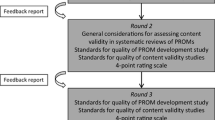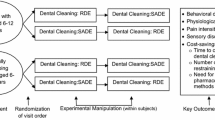Abstract
Provider-patient relations may influence the nature of care provided. The aim of this study was to examine dentist preferences for patients, relate these to characteristics of dentists and practices, and to services provided. A random sample of Australian dentists completed mailed questionnaires (response = 60.3%). Four factor-based subscales and an overall scale (Selectivity) were derived from a 37-item battery. The 4 subscales comprised treatment adherence (behavior relevant to the treatment situation), personal adaptability (willingness to cooperate when expected to do so), social interactiveness (positive affect, communicativeness, and appreciativeness), and enabling characteristics (willing and able to pay, and good dental knowledge). Reliability was adequate (Cronbach’s α = 0.71–0.90). Treatment adherence was associated with higher orthodontic rates, but a lower extraction rate; social interactiveness was associated with higher extraction and denture rates; personal adaptability was associated with higher orthodontic rates, but lower general/miscellaneous service rates; enabling characteristics was associated with higher endodontic and crown and bridge rates; selectivity was associated with higher rates of diagnostic, preventive, and total services per visit. The associations with service rates indicated that provider preferences were related to treatment behavior that could affect the mix of services, indicating that the nature of care provided may be influenced by the provider-patient relation.
Similar content being viewed by others
References
Australian Dental Association. (1992, November). Schedule of Dental Services. ADA News Bulletin (Suppl).
Ayer, W. A. (1981). Dental providers and oral health behaviour. Journal of Behavioral Medicine, 4, 273–282.
Bader, J. D., & Shugars, D. A. (1995). Variation, treatment outcomes, and practice guidelines in dental practice. Journal of Dental Education, 59, 61–95.
Brennan, D. S., Spencer, A. J., & Szuster, F. S. P. (1998). Service provision trends between 1983–84 and 1993–94 in Australian private general practice. Australian Dental Journal, 43, 331–336.
Child, D. (1978). The essentials of factor analysis. London: Holt, Rinehart and Winston.
Davies, A. R., & Ware, J. E. (1981). Measuring patient satisfaction with dental care. Social Science and Medicine, 15A, 751–760.
Frazier, P. J., Jenny, J., Bagramian, R. A., Robinson, E., & Proshek, J. M. (1977). Provider expectations and consumer perceptions of the importance and value of dental care. American Journal of Public Health, 67, 37–43.
Johnson, R. A., & Wichern, D. W. (1988). Applied multivariate statistical analysis (2nd ed.). Englewood Cliffs, NJ: Prentice-Hall.
Kay, E., & Nuttall, N. (1995). Clinical decision making—An art or a science? Part V: Patient preference and their influence on decision making. British Dental Journal, 178, 229–233.
Kim, J., & Mueller, C. W. (1978). Factor analysis. Statistical methods and practical issues. Sage university paper series on quantitative applications in the social sciences, 07–014. Beverly Hills: Sage.
Lahti, S., Tuutti, H., Hausen, H., & Kaariainen, R. (1992). Dentist and patient opinions about the ideal dentist and patient. Developing a compact questionnaire. Community Dentistry and Oral Epidemiology, 20, 229–234.
Lahti, S., Tuutti, H., Hausen, H., & Kaariainen, R. (1995). Comparison of ideal and actual behaviour of patients and dentists during dental treatment. Community Dentistry and Oral Epidemiology, 23, 374–378.
Linn, E. L. (1971). Women dental students. Women in a man’s world. Millbank Memorial Fund Quarterly, 49, 63–76.
Maryniuk, G. A. (1990). Practice variation: Learned and socio-economic factors. Advances in Dental Research, 4, 19–24.
O’Shea, R. M., Corah, N. L., & Ayer, W. A. (1983). Dentists– perceptions of the ‘good’ adult patient: An exploratory study. Journal of the American Dental Association, 106, 813–816.
Over, R., Spencer, A. J., & McDougall, W. (1984). Career choice, plans and expectations of male and female students in dental science. Australian Dental Journal, 29, 189–194.
Redford, M., & Gift, H. C. (1997). Dentist-patient interactions in treatment decision-making: A qualitative study. Journal of Dental Education, 61, 16–21.
Rouse, R. A., & Hamilton, M. A. (1991). Dentists evaluate their patients: An empirical investigation of preferences. Journal of Behavioral Medicine, 14, 637–648.
Salant, P., & Dillman, D. (1994). How to conduct your own survey. New York: Wiley and Sons.
SAS Institute. (1988). SAS/STAT user’s guide. Version 6.03. Cary, NC: Author.
SAS Institute. (1990). CALIS and LOGISTIC procedures. Version 6.04. Cary, NC: Author.
Sondell, K., & Soderfeldt, B. (1997) Dentist-patient communication: a review of relevant models. Acta Odontologica Scandinavica, 55, 116–126.
Streiner, D. L., & Norman, G. R. (1995). Health measurement scales. A practical guide to their development and use (2nd ed.). Oxford, England: Oxford University Press.
Szuster, F. S. P., & Spencer, A. J. (1997). Dental practitioner statistics, Australia, 1994 (AIHW Dental Statistics and Research Series, No. 11). Adelaide, Australia: University of Adelaide.
Weinstein, P., Milgrom, P., Ratener, P., Read, W., & Morrison, K. (1978). Dentists’ perceptions of their patients: relation to quality of care. Journal of Public Health Dentistry, 38, 10–21.
Weinstein, P., Milgrom, P., Ratener, P., & Morrison, K. (1979). Patient dental values and their relationship to oral health status, dentist perceptions and quality of care. Community Dentistry and Oral Epidemiology, 7, 121–127.
Williams, S. J., & Calnan, M. (1991). Convergence and divergence: assessing criteria of consumer satisfaction across general practice, dental and hospital care. Social Science and Medicine, 33, 707–716.
Wills, T. A. (1978). Perceptions of clients by professional helpers. Psychological Bulletin, 85, 968–1000.
Author information
Authors and Affiliations
Corresponding author
Rights and permissions
About this article
Cite this article
Brennan, D.S., Spencer, A.J. Dentist preferences for patients: dimensions and associations with provider, practice, and service characteristics. Int. J. Behav. Med. 13, 69–78 (2006). https://doi.org/10.1207/s15327558ijbm1301_9
Issue Date:
DOI: https://doi.org/10.1207/s15327558ijbm1301_9




